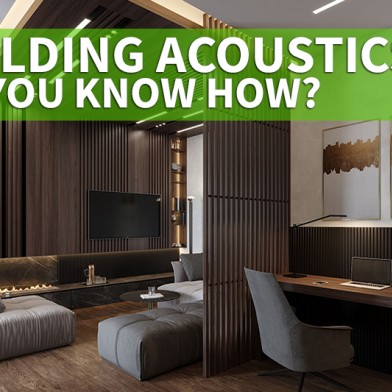Building acoustics - know how?
- 17 October 2022 23:20:21
- Reviews: 0
- Views: 367
-

When we say building acoustics, in theory and practice, we primarily mean the acoustic separation of two rooms inside a building or a building as such and the external environment. This article will focus on the basic concepts and aspects of building acoustics and their practical application.
The basic idea of building acoustics
To get serious about building acoustics, we must first introduce the basic concepts, and then relate these concepts to each other in such a way that it is always clear what specific problem we are solving within the framework of building acoustics. This may seem like a dry theory, but it is needed so that our procedure, which led to a successful solution in one case, can be transferred to another.
The basis is the division into source and profitable premises. Only if we clearly define the spaces between which we want to define acoustic parameters can we create a well-tolerated measurement system. As a rule, these are two rooms above each other, separated by a ceiling / floor, but these can also be rooms adjacent on the same floor, or even indirectly adjacent rooms, depending on the requirements of the architect or the client in general.
The next step in analyzing building acoustics is choosing the type of sound transmission we want to focus on. Basically, it can be of three types:
- An over-the-air transmission that originates from any normal sound, such as speech. Such sound propagates through the air, and when it hits the walls of the room, it partially passes through and is partially reflected.
- The second category includes sounds from sources that are in direct contact with the building material and shake it with mechanical vibration, most often this is a device lying directly on the ground or next to a wall. Both of these categories, of course, are not completely mutually exclusive and overlap.
- The third option is the so-called footstep sounds, which are made randomly when hitting the floor, such as footsteps, moving furniture, falling objects, and the like.
Sound transmission and soundproofing
But what parameters do we really want to know? In the dictionary of building acoustics, we can find many different coefficients, calculated in different units of measurement, which allow a very accurate description of the propagation of sound through a building, but may be incomprehensible to a non-specialist. Moreover, they are of no use to us during the construction itself, their importance lies in the fact that they allow us to measure and compare different types of insulation, and then choose the one that best suits our requirements during implementation. The coefficients used are also often specified in the specification of the insulating material, so knowing them can help us when buying.
So how is it with sound transmission and sound insulation? Sound transmission tells us what percentage of acoustic power is passing through the wall to the other side. When we encounter a sound transmission coefficient of 0.32 for example, this means that 32% of the acoustic power will pass through. On the other hand, soundproofing tells us how many times the incoming power is greater than the outgoing one. Since these are very small numbers, they are converted to decibels (dB), which do not grow linearly, but exponentially (if the distance were measured in dB, then the distance between 1 and 2 dB would be shorter than between 3 dB). and 4 dB).
We can always measure or calculate the total sound insulation only for the entire structure, and not just for the element itself.
Influence of the structure on the acoustics of the building.
Thus, the result depends on the individual solution of the insulating structure. If it is a simple partition, how is it attached to the surrounding elements, to the ceiling, to the walls or to the floor, has an inserted flexible layer been used yet, and so on. Without going into details, it was thanks to accurate measurements and calculations of the sound insulation of various composite acoustic blocks (walls, partitions, obstacles) that it was established which types of insulation are the most effective.
In fact, for the most effective soundproofing, it is necessary to separate the source and reception as best as possible, directly physically. So, for example, use partitions with an air gap, which significantly improves sound insulation. Another principle is to reduce sound bridges. These are mechanical connections that must be in the crossbar for structural reasons, such as handles, couplings, and the like. Of course, a wall can never stand in the air, but with the help of flexible materials, certain improvements can always be achieved here.


